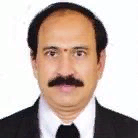
P. Chandra Sekhar
Work place: University College of Engineering, Osmania University, Hyderabad, India
E-mail: sekharpaidimarry@gmail.com
Website:
Research Interests: Signal Processing, Algorithm Design, Analysis of Algorithms
Biography
Prof. Chandra Sekhar Paidimarry received BE degree from Nagpur University, M.Tech degree from JNTU Hyderabad and Ph.D from Osmania University in 1991, 1999 and 2009 respectively. He had been awarded with Post-Doctoral Fellowship by Shizuoka University, Japan for one year. He has been working in the Department of Electronics and Communication Engineering, University College of Engineering, Osmania University, Hyderabad from 2001. He has been elevated as Professor of ECE in 2015. He is served as Head of Department, ECE, and Osmania University. His research interests include Development of high performance Computational Electromagnetic and efficient FPGA based signal processing algorithms and Design Automation. He is working presently as Prof. andVice-Principal in University College of Engineering, Osmania Univeristy
Author Articles
Design and Analysis of an Elliptical Edge with Pentagon Slot Patch Antenna for 5G Applications
By Pendli Pradeep K. Jaya Sankar P. Chandra Sekhar
DOI: https://doi.org/10.5815/ijwmt.2022.05.04, Pub. Date: 8 Oct. 2022
This paper presents a design of modified rectangular patch antenna with a pentagon slot and elliptical-shaped strip at the edge of the antenna for Sub-6G band 5G wireless applications. The proposed antenna excited using a 50-ohm coaxial cable transmission line. The overall dimensions of the substrate are 49.72 x 43.02 x 1.7 mm3 used on a Rogers RTDuroid 5880(TM) with relative permittivity of ∈r=2.2. The proposed antenna is simulated using Ansys HFSS Software at a resonant frequency of 3.2 GHz. The experimental and simulated results are matched well. The measured return loss value of the antenna is -20 dB at 3.2 GHz frequency, which can cover an impedance bandwidth of 150MHz. The proposed antenna provides a stable radiation pattern, radiation efficiency is 96%, and peak gain is 4.6 dBi. This antenna finds applications for WiMAX wireless broadband communication, radar, and commercial Wireless LAN in S-band.
[...] Read more.Other Articles
Subscribe to receive issue release notifications and newsletters from MECS Press journals